If you could travel anywhere in the world and try one typical dish, which would you choose?
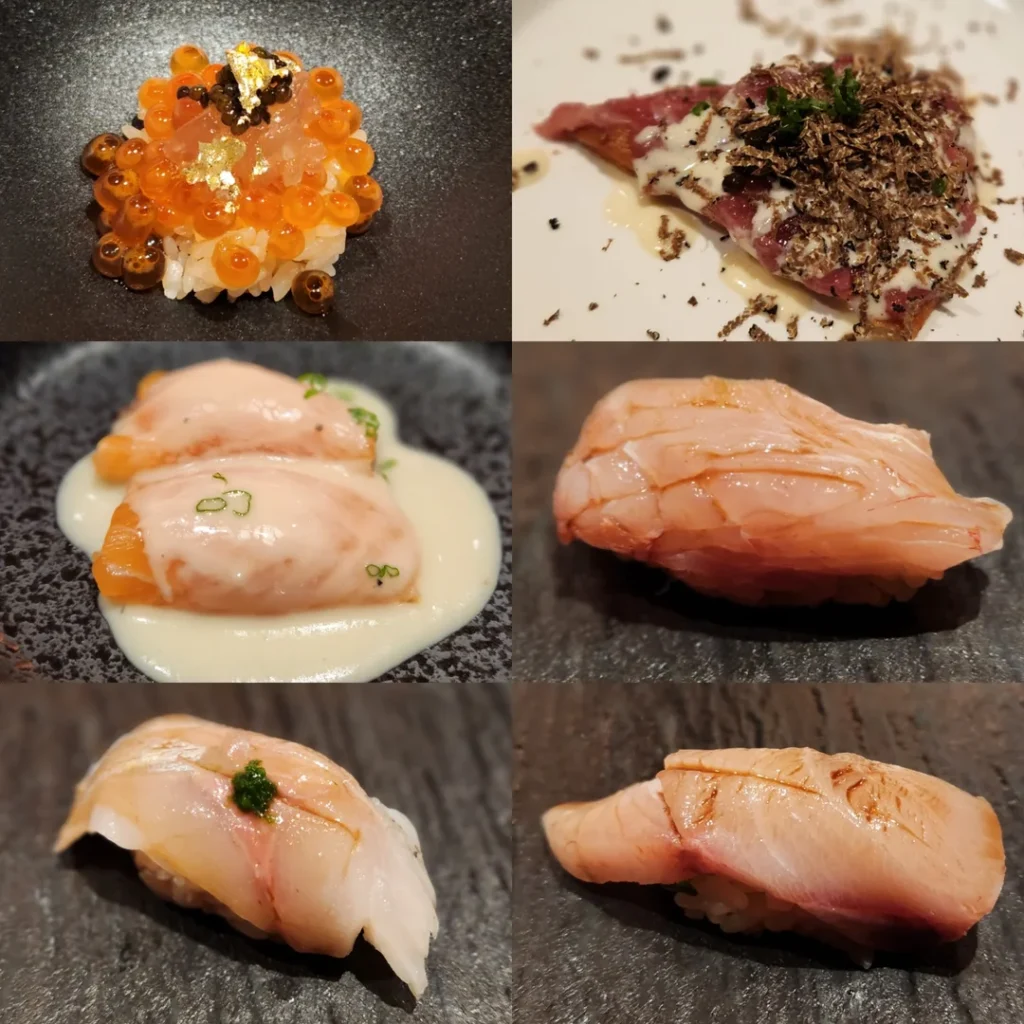
High Quality Sushi: An Exceptional Dining Experience
What defines high quality sushi?
When we talk about “high quality sushi”, we are referring to a gastronomic experience that goes beyond the simple pleasure of eating. It is a dish prepared with fresh ingredients, hand selected, and precise techniques, resulting in a unique combination of flavors, textures and aromas.
Characteristics of high quality sushi:
Fresh fish: The main ingredient of sushi is raw fish. In a high-quality sushi, the fish is extremely fresh, with firm texture and intense flavor. It is cut precisely to ensure that each piece has the best part of the fish.
Special Japanese rice: The rice used for sushi is a specific type, short grain and sticky. It is cooked at the right point, with the ideal amount of rice vinegar, sugar and salt.
Fresh and quality ingredients: In addition to fish and rice, the other ingredients used in sushi, such as nori (seaweed), wasabi and ginger, are also of high quality.
Flawless presentation: The presentation of a high-quality sushi is as important as the taste. Each piece is carefully assembled, with attention to detail, creating a culinary masterpiece.
Sushiman skill: The skill of the sushiman is fundamental to the quality of sushi. A good sushiman knows how to choose the best ingredients, how to cut them and how to assemble them to enhance flavors.
What to expect from a high quality sushi:
When savoring a high-quality sushi, you can expect an explosion of flavors in your mouth. The texture of fresh fish blends perfectly with the soft rice and the light spicy touch of wasabi. Each bite is a unique experience, pleasing to both the palate and vision.
Types of high quality sushi:
There are several types of sushi, each with its own characteristics and flavors. Some of the most popular include:
Nigiri: Pieces of sushi consisting of a rice ball covered with a slice of raw fish.
Sashimi: Thin slices of raw fish, served without rice.
Maki: Sushi rolls wrapped in nori, with various fillings.
Uramaki: Sushi rolls inverted, with rice on the outside and filling inside.
Where to find high quality sushi:
To find high-quality sushi, look for restaurants specializing in Japanese cuisine, with experienced chefs and fresh ingredients. You can also find high quality sushi in markets specializing in Japanese products.
In summary:
The high quality sushi is a unique gastronomic experience, combining tradition and modernity. If you are a lover of Japanese food, it is worth trying sushi prepared by a true master.

Fresh pasta in Italy: A Feast for the Senses
“Fresh pasta in Italy” translates to “fresh pasta in Italy” and represents one of the pillars of Italian cuisine. By ordering this dish, you are preparing for a unique gastronomic experience, full of flavor, tradition and passion.
What is Fresh Pasta?
The fresh pasta, as its name suggests, is made on the spot, usually with simple ingredients such as flour, eggs and water. Unlike the dry mass that we find in supermarkets, fresh pasta has a softer texture and more intense flavor, because it does not pass through industrial drying processes.
The Variety of Fresh Pasta
Italy is famous for its diversity of fresh pasta, each with its characteristic shape, texture and name. Some of the most popular include:
Tagliatelle: Wide, flat strips, perfect for creamy sauces and ragù.
Fettuccine: Similar to tagliatelle, but a little thinner.
Pappardelle: Wide and thick ribbons, ideal for robust sauces.
Ravioli: Stuffed pasta, which can have different types of filling, such as meat, cheese or vegetables.
Tortellini: Small stuffed rings, usually with meat or cheese.
The Traditional Preparation
The preparation of fresh pasta is an art that is passed on from generation to generation. The dough is kneaded by hand until it has a smooth and elastic texture. Then it is opened with a roll or dough machine and cut into the desired shape.
Perfect Accompaniments
Fresh pasta is a blank canvas, ready to receive the most diverse sauces and accompaniments. Some of the classics include:
Ragù alla Bolognese: A slow and tasty beef sauce.
Pesto alla Genovese: A vibrant green sauce made with fresh basil, pine nuts, parmesan cheese and olive oil.
Carbonara: A creamy sauce made with eggs, pecorino romano cheese and guanciale (salted pork cheek).
(salted pork cheek).
Pomodoro: A simple but delicious fresh tomato sauce.
Where to Experiment?
To taste the true fresh Italian pasta, the ideal is to visit a trattoria or a family restaurant. There, you can enjoy the pasta made on time, with fresh and high quality ingredients.
In short, fresh pasta in Italy is much more than just a dish. It’s a sensory experience that celebrates tradition, simplicity and passion for good food. If you have the opportunity to taste it, don’t miss out!
3 Street tacos in Mexico
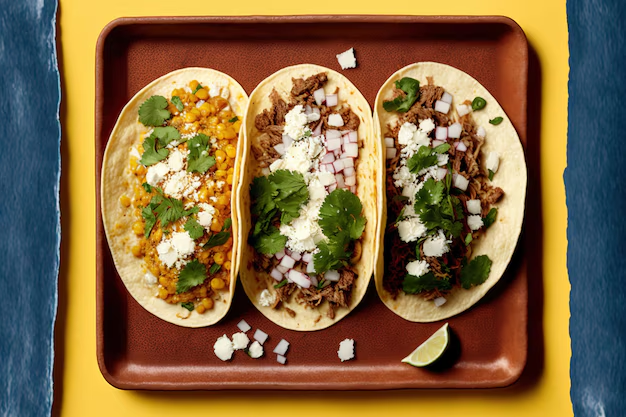
OStreet tacos are an iconic part of Mexico’s food culture and an unmissable experience for anyone visiting the country. These delicacies are sold in carts, stalls or small cafes, generally in vibrant and lively environments. Among the most popular types are:
Tacos al Pastor
Inspired by Arabic shawarma, tacos al pastor are made with pork marinated in a mixture of spices and pepper, often with achiote, which gives it its characteristic reddish color. The meat is roasted on a vertical spit (similar to a kebab) and thinly sliced before being placed on a corn tortilla, accompanied by pineapple, onion, cilantro and, sometimes, a spicy salsa.
Carnitas Tacos
Carnitas are pieces of pork that are slowly cooked in their own fat until tender and flavorful. They are served in tortillas and combined with simple garnishes such as onion, cilantro, lime and a variety of salsas ranging from mild to very spicy.
These tacos are always prepared to order, with fresh ingredients that guarantee authentic and irresistible flavors. The experience of eating street tacos in Mexico goes beyond the food; It’s an opportunity to connect with local culture, while enjoying the aroma of spices and the heat of the Mexican streets.
4 authentic brazilian barbecue
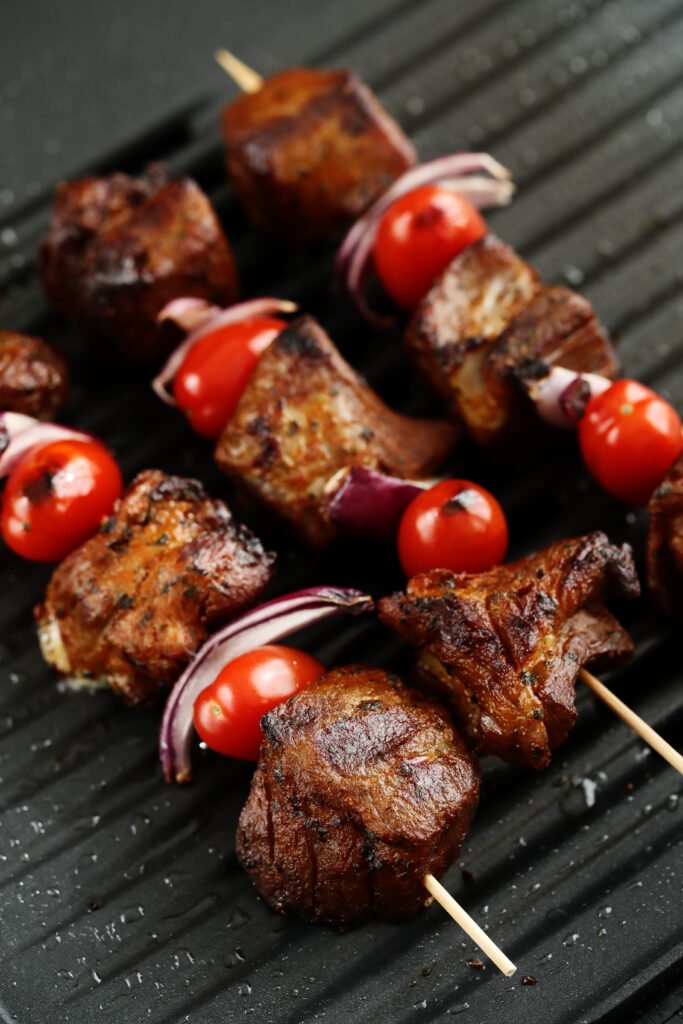
Authentic Brazilian barbecue is a culinary tradition that was born in the south of Brazil, especially in the Pampas region, where the habit of roasting meat on skewers over hot coals was popularized by the gauchos. This style of preparation is much more than a culinary technique; It is a cultural and social celebration, marked by the gathering of friends and family around the fire.
Main characteristics of Brazilian barbecue:
Cutting of Meat:
The most traditional cuts include picanha, brisket, rib, rump and skirt steak.
Meats such as sausage, chicken hearts and pork cuts are also popular.
Preparation method:
Meats are generally seasoned only with coarse salt, which enhances the natural flavor.
They are roasted over an open fire or on charcoal or wood grills, with the skewers rotated to ensure uniform cooking.
Side dishes:
Classic dishes include rice, tropeiro beans, farofa, mayonnaise salad, vinaigrette and garlic bread.
In some regions, they serve chimichurri or barbecue sauce as an additional option.
Today, Brazilian barbecue is known and appreciated internationally, with specialized restaurants, such as rodízio steakhouses, which feature a wide variety of meats and serve customers directly at the table. The barbecue experience is an expression of Brazilian hospitality, flavor and tradition.
.
5 Croissants in Paris

Croissants in Paris are icons of French cuisine and a true symbol of local culture. This pâtisserie classic is loved by both Parisians and tourists visiting the city.
Made from a butter-rich puff pastry, croissants are known for their light, crispy texture on the outside, with soft, fluffy layers on the inside. The preparation process is meticulous, involving several steps of folding the dough to create the famous layers. The quality of the butter used is crucial to guarantee the characteristic flavor and perfect texture.
Croissants are traditionally eaten for breakfast, accompanied by a cup of coffee or hot chocolate. In addition to the classic croissant au beurre (with butter), there are popular variations such as pain au chocolat (a version filled with chocolate bars) and croissants filled with almonds or other ingredients.
If you visit Paris, a stop at a local boulangerie is almost mandatory to try a fresh croissant. Places like Maison Pichard, Du Pain et des Idées, and Blé Sucré are known for offering some of the best croissants in the city.
“Eating wisely is nourishing the body and mind with intelligence and balance”
6 Thai curry
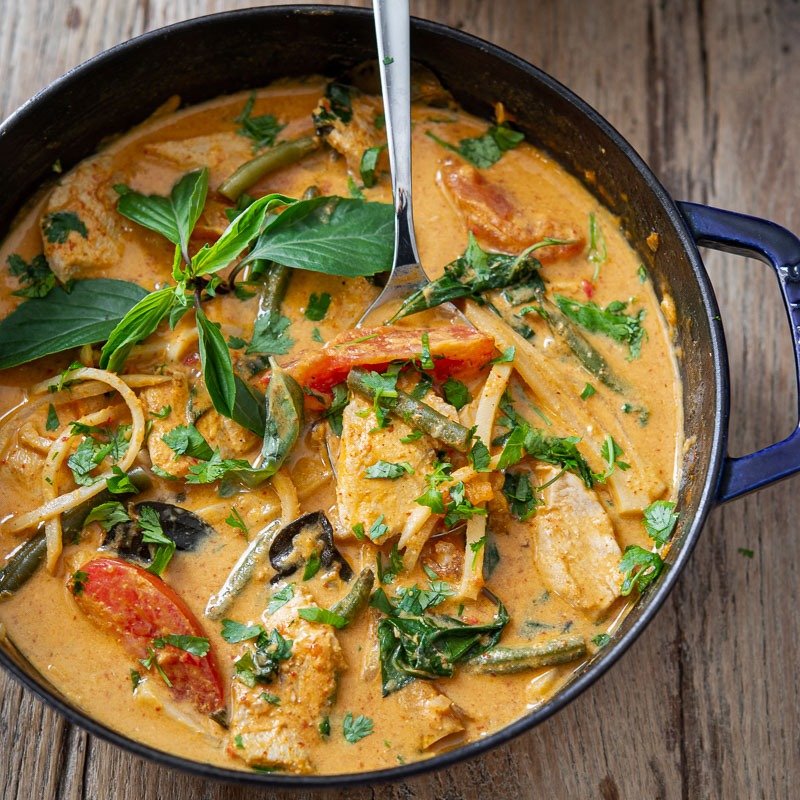
Thai curry is a traditional dish of Thai cuisine, famous for its aromatic, spicy and rich flavor. It is based on a curry paste that combines herbs, spices and other fresh ingredients such as pepper, garlic and ginger, which are often ground together into a paste. The dish can vary greatly depending on the type of curry chosen. The main types include:
Green Curry
It is the spiciest among Thai curries, made with green pepper, coconut milk, lemongrass, kaffir lime leaves and Thai basil.
Combined with proteins like chicken, fish or tofu and vegetables like Thai eggplant.
Red Curry
It has a milder and sweeter taste compared to the green one, prepared with dried red pepper, coconut milk and spices.
It is popular with meats such as beef, duck or shrimp.
Yellow Curry
Less spicy and with a slightly sweet touch, thanks to the presence of saffron, coriander and cumin.
Usually served with chicken or seafood.
Curry Massaman
One of the softest, with a Muslim influence. It contains spices such as cinnamon, cardamom and cloves, as well as potatoes and peanuts.
It is commonly served with beef or lamb.
Curry Panang
Similar to red curry, but thicker and slightly sweeter, made with coconut milk and peanut butter.
Thai curries are usually served with jasmine rice, which helps balance the dish’s intense, spicy flavor. They are an expression of the typical balance of Thai cuisine, which mixes sweet, spicy, acidic and salty flavors.
7 Black truffle
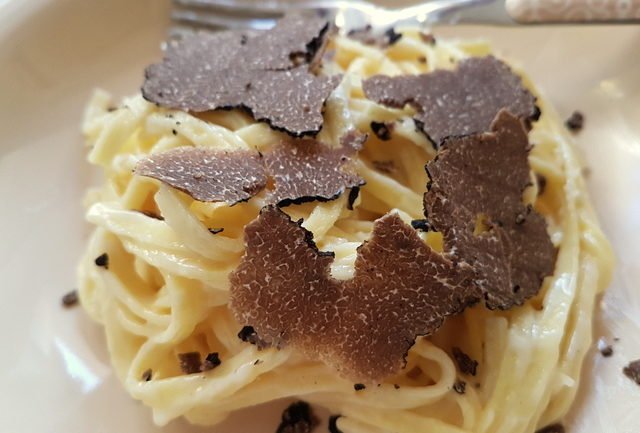
The Black Truffle (tuber melanosporum), or black truffle, is one of the most sophisticated and expensive ingredients in the culinary world. It is an underground fungus that grows in symbiosis with the roots of certain trees, such as oaks and hazelnut trees. Originating mainly from the Périgord region, in France, and widely cultivated in Mediterranean countries such as Italy and Spain, the black truffle is appreciated for its intense flavor and unique aroma, which combines earthy, woody and slightly musky notes.
Main Features:
Aroma and flavor: Intense, complex and unmistakable. They are described as a combination of damp earth, nuts and a touch of dark chocolate.
Texture: The rind is rough and black, while the interior has a marbled pattern with white veins.
Harvesting: It is traditionally done between November and March, with the help of dogs or pigs trained to detect the aroma of the underground fungus.
Culinary uses:
Black truffle is used as a luxurious condiment to enhance simple and elegant dishes. It is often grated, thinly sliced or used in infusions to:
Risottos and pasta.
Meats, eggs and cheeses.
Truffle butters and oils.
Interesting facts:
Truffle cultivation, known as truffle farming, is a time-consuming and challenging process, as climatic conditions and soil type play a crucial role.
Due to its rarity and high demand, the black truffle is considered a luxury item, with prices that can exceed 1,000 euros per kilo.
If you’re thinking about trying it or using it in recipes, it’s worth exploring how its unique aroma transforms dishes into memorable gastronomic experiences!
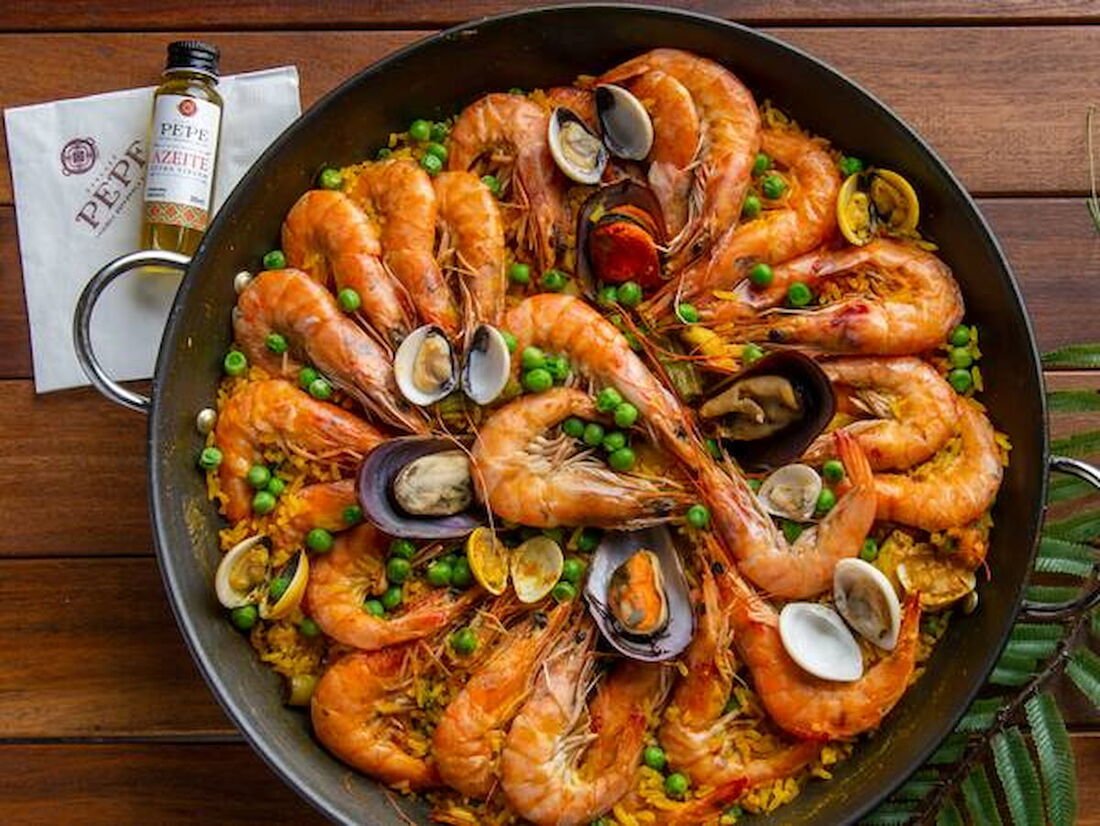
The Spanish Paella: A Classic of Gastronomy
Paella is an iconic dish of Spain, especially associated with the Valencia region. It is prepared in a shallow pan with a wide bottom, called paella, and traditionally cooked outdoors, which gives it an authentic smoked flavor.
Ingredients:
The composition of paella can vary greatly, depending on the region and the ingredients available. However, some elements are almost always present:
Rice: The pump rice is the most used, for its ability to absorb the broth without breaking.
Broth: Usually made with fish, chicken or both, the broth infuses flavor to the dish.
Meat: Chicken, rabbit and in some versions, shellfish like shrimps, squid and mussels.
Vegetables: green beans, peppers, tomatoes and turmeric, which gives the characteristic yellow color.
Olive oil: Essential for the taste and texture of the dish.
Preparation:
Sauté: The ingredients are sautéed in the paella with olive oil, starting with the denser meats and vegetables.
Add the rice: The rice is incorporated into the braised and lightly toasted.
Cooking with the broth: Hot broth is added until it covers the rice, and the paella is cooked over low heat until the liquid is absorbed.
Finishing: The seafood is added in the last minutes of cooking, so that they do not harden.
Varieties:
There are numerous variations of paella, each with its specific characteristics and ingredients:
Paella Valenciana: The most traditional, with chicken, rabbit, green beans and garrofó (a type of white bean).
Paella marinera: Dominated by seafood, such as shrimps, squid and mussels.
Paella Mixta: Combines meat and seafood.
Vegetarian Paella: No meat, with a variety of vegetables and seasonings.
Flavors and Textures:
Paella is a tasty and aromatic dish, with a creamy texture inside and crispy edges. The combination of ingredients and cooking method result in a balanced and satisfying dish.
Where to try:
The best way to enjoy an authentic paella is in a paellada in Spain, especially in the region of Valencia. However, you can find good versions in many Spanish restaurants around the world.
Tips:
Accompaniments: Paella is traditionally accompanied by a green salad and bread.
Wine: A dry white wine or a light red one goes well with paella.
Tradition: Paella is more than a dish, it’s a tradition and a way to gather friends and family.
Mille-Feuille: A Classic and Delicate Delight
Mille-Feuille, also known as mille-feuilles, is a mouth-watering French dessert, famous for its crunchy texture and delicate layers. Its name, which means “thousand leaves” in French, refers to the many thin layers of puff pastry that make up this dessert.
How it is done:
Puff pastry base: The base of the Mille-Feuille is made up of several thin layers of puff pastry, lightly sweetened and baked until crispy and golden.
Delicate cream: Between the layers of dough, a soft and tasty cream is applied, usually based on vanilla, but variations can be found with other flavors such as chocolate or fruit.
Finishing touch: The dessert is finished with a icing sugar coating, which adds a touch of sweetness and an elegant look.
The taste:
The taste of Mille-Feuille is a perfect combination between the crisp pastry and the creaminess of the filling. The balanced sweetness and unique texture make this dessert an unforgettable gastronomic experience.
Trivia:
Origin: The Mille-Feuille is believed to have originated in France in the 17th century.
Versions: There are several variations of the Mille-Feuille, with different types of cream and fruits.
Special occasions: It is a perfect dessert for special occasions, such as parties and birthdays.
In summary:
Mille-Feuille is a classic and elegant dessert, which delights for its beauty and taste. If you like sophisticated sweets with a unique texture, this is a dessert that you need to try.
Queijos Artesanais

Queijos Artesanais: Uma Explosão de Sabores
Os queijos artesanais são verdadeiras obras-primas da culinária, produzidos de forma tradicional e com ingredientes naturais, resultando em sabores únicos e texturas irresistíveis. Diferentemente dos queijos industrializados, que seguem processos padronizados e geralmente têm um sabor mais suave, os queijos artesanais variam muito em sabor, aroma e aparência, refletindo a região onde são produzidos, o tipo de leite utilizado (vaca, cabra, ovelha ou búfala) e as técnicas de produção artesanal.
Características dos Queijos Artesanais:
Sabores intensos e complexos: Os queijos artesanais têm uma gama de sabores que vão do suave e cremoso ao forte e picante, com notas de frutas, nozes, especiarias e até terra.
Texturas variadas: A textura dos queijos artesanais pode ser macia, cremosa, firme, quebradiça ou até mesmo esfarelada, dependendo do tipo de queijo e do tempo de cura.
Produção artesanal: A produção de queijos artesanais é um processo lento e cuidadoso, que envolve a seleção dos melhores ingredientes, a coagulação do leite, a moldagem e o refino dos queijos.
Variedade: Existem milhares de tipos de queijos artesanais ao redor do mundo, cada um com suas próprias características e histórias.
Alguns exemplos de queijos artesanais famosos:
Queijo Brie: Originário da França, este queijo macio de casca branca é cremoso e tem um sabor levemente adocicado.
Parmesão: Queijo italiano duro e salgado, com sabor intenso e complexo, ideal para ralar sobre massas e saladas.
Gorgonzola: Queijo italiano azul, com veios azuis e forte sabor picante.
Cheddar: Queijo inglês firme, sabor laranja, com um sabor levemente ácido e salgado.
Roquefort: Queijo francês azul, cremoso, com um sabor intenso e picante.
Como apreciar os queijos artesanais:
Temperatura: A temperatura ideal para degustar um queijo artesanal é entre 15°C e 20°C.
Accompaniments: The artisanal cheeses combine very well with artisan breads, fruits, honey, nuts, jams and wines.
Tasting: Try different types of artisan cheeses and discover your favorite flavors.
Why consume artisanal cheeses?
Unique taste: The artisanal cheeses offer a unique and unforgettable gastronomic experience.
Quality: The handmade cheeses are produced with natural ingredients and high quality, without chemical additives.
Sustainability: By consuming artisanal cheeses, you support local production and family farming.
In short, artisan cheeses are a true celebration of culinary diversity and a delight for the senses. If you are a cheese lover, be sure to try this variety of flavors and textures.
Revitalize seu corpo naturalmente
Cansado dos mesmos velhos truques de dieta?
We understand the frustration. Endless diets, restrictive eating plans, and countless hours at the gym – it can all feel overwhelming. But what if there was a natural way to boost your metabolism and shed those extra pounds without sacrificing your favorite foods?
The Power of Food
Certain foods have the incredible ability to ignite your body’s metabolism, helping you burn calories more efficiently. By incorporating these nutrient-rich foods into your daily diet, you can jumpstart your weight loss journey and achieve your health goals.
How Does It Work?
- Metabolic Boost: These foods contain essential nutrients and compounds that rev up your metabolism, allowing your body to burn calories at a faster rate.
- Detoxification: They aid in the elimination of toxins, reducing the burden on your liver and kidneys and promoting overall health.
- Improved Digestion: By supporting optimal digestion, these foods can help prevent bloating, constipation, and other digestive issues.
Remember: While these foods can be a powerful tool, they work best when combined with a balanced diet and regular exercise.
Ready to Transform Your Body?
Descubra o segredo para uma vida mais saudável e feliz. [Functional foods]
Functional foods is your key to unlocking your body’s potential. It’s time to take control of your health and achieve the body you deserve.
Order now and start your journey to a healthier, more vibrant you!

